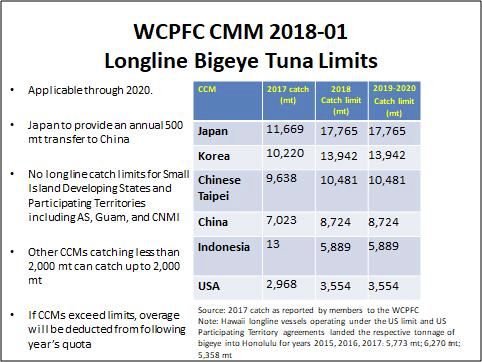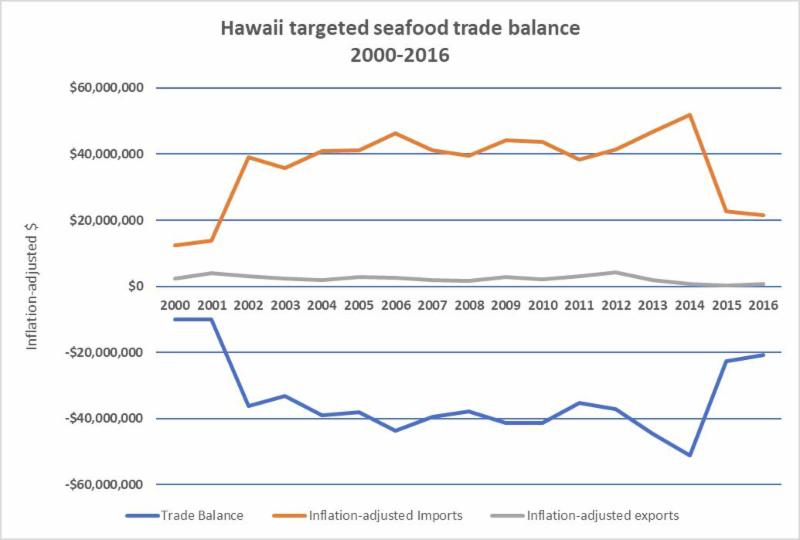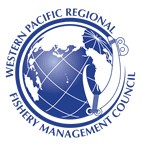HONOLULU, HI / ACCESSWIRE / June 28, 2019 / The Western Pacific Regional Fishery Management Council, yesterday in Honolulu, recommended removing the 2,000 metric (mt) annual catch limit for bigeye tuna caught by longline in the Western and Central Pacific Ocean (WCPO) for the US Pacific Territories of American Samoa, Guam and the Commonwealth of the Northern Mariana Islands (CNMI). Removal of the catch limit would bring parity between the US Territories and other Territories and Small Island Developing States (SIDs) in the region. The recommendation will go the US Secretary of Commerce for approval as part of Amendment 9 to the Pacific Pelagic Fishery Ecosystem Plan (FEP) for the Western Pacific Region.

Under the Western and Central Pacific Fisheries Commission (WCPFC), an international regional fishery management organization to which the United States belongs, Participating Territories (including the US Territories) and SIDS have no longline-caught bigeye tuna limit in the WCPO. This is because the WCPFC recognizes the aspiration of SIDS and Participating Territories to develop their fisheries. The Council, however, recommended and the National Marine Fisheries Service (NMFS) established limits of 2,000 mt per US Territory under Amendment 7 of the Pelagic FEP for the Western Pacific Region. This was at a time when there was some concern about the status of the Pacific bigeye tuna stock. Subsequently, the 2017 and 2018 bigeye tuna stock assessments by the Pacific Community (SPC), the science provider for the WCPFC, show the Western stock as being neither overfished nor experiencing overfishing.
Besides removing the WCPO longline-caught bigeye limit for the US Territories, the Council yesterday recommended that each US Territory be allowed to allocate up to 1,500 mt of its quota to federally permitted, Hawai'i-based longline vessels under specified fishing agreements for fishing years 2020 through 2023. Currently under Amendment 7 of the Pelagic FEP, the allocation level is set at 1,000 mt per Territory per year.
Fees paid by vessels to the Territories under these agreements are deposited into the Western Pacific Sustainable Fisheries Fund (WPSFF) for projects identified by the governor of each Territory in its respective Marine Conservation Plan (MCP). The National Marine Fisheries Service (NMFS) Pacific Islands Regional Office oversees the WPSFF, while the Council administers sub-awards from the fund to the Territories. The Council has recommended that fees from the agreements go directly to the Territories, which would require a revision to the section regarding the WPSFF in the Magnuson-Stevens Fishery Conservation and Management Act.
Eric Kingma, executive director of the Hawaii Longline Association (HLA), noted during public comments that the allocation increase would provide "more flexibility in these agreements, as well as the utilization of a resource that is not experiencing overfishing or overfished, and the opportunity for Territories to benefit."
FAST FACTS ABOUT THE HAWAII LONGLINE BIGEYE TUNA FISHERY AND QUOTA
- Local longline fleet for bigeye tuna is the largest food producer in Hawai'i, landingabout 5,358 mt based on 2017 data. This better reflects the capacity of the fleet and the demand of its market.
- About 80 percent of the landings remain in the islands, yet the amount of imports of fish species targeted by the local fisheries has been increasing.
- The US quota of longline-caught bigeye tuna in the WPCO set by the WCPFC for 2018-2020 is 3,554 mt. This amount is based on the catch by the Hawai'i-based longline fleet in 2014 minus a few incremental decreases over the years.

Under the Magnuson-Stevens Fishery Conservation and Management Act of 1976, the Council has authority over fisheries seaward of state waters in Hawaiʻi and other US Pacific Islands. The Council meeting concludes today at the YWCA Fuller Hall at 1040 Richards St. For more information, go to www.wpcouncil.org; email [email protected] or phone (808) 522-8220.
Western Pacific Regional Fishery Management Council: Secretary of Commerce appointees from nominees selected by American Samoa, CNMI, Guam and Hawaiʻi governors: Archie Soliai, StarKist (American Samoa) (chair); Christinna Lutu-Sanchez, commercial fisherman (American Samoa) (vice chair); John Gourley, Micronesian Environmental Services (CNMI) (vice chair); Michael Duenas, Guam Fishermen's Cooperative Association (Guam) (vice chair); Dean Sensui, Hawaii Goes Fishing (Hawaiʻi) (vice chair); Michael Goto, United Fishing Agency (Hawaiʻi); Edwin Watamura, Waialua Boat Club (Hawaiʻi); McGrew Rice, charter boat captain (CNMI). Designated state officials: Raymond Roberto, CNMI Dept. of Lands and Natural Resources; Suzanne Case, Hawaiʻi Dept. of Land & Natural Resources; Chelsa Muña-Brecht, Guam Dept. of Agriculture; Henry Sesepasara, American Samoa Dept. of Marine & Wildlife Resources. Designated federal officials (voting): Michael Tosatto, NMFS Pacific Islands Regional Office. Designated federal officials (non-voting): RADM Kevin Lunday, USCG 14th District; Michael Brakke, US Department of State; Brian Peck, USFWS.
CONTACT:
Sylvia Spalding, 808-522-7498
[email protected]
SOURCE: The Western Pacific Regional Fishery Management Council




